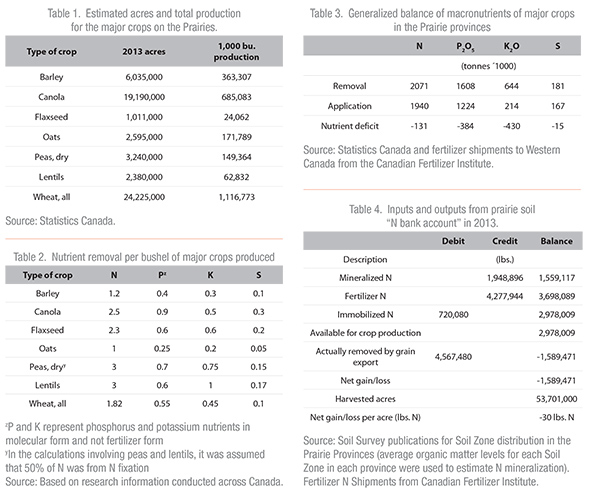
Features
Agronomy
Fertility and Nutrients
Big crops come with a price
Photo by Bruce Barker.
Jan. 9, 2014 - Bin busting yields are good news for farmers across the Prairies. With relatively good commodity prices, and fertilizer prices somewhat lower than their highs of the last few years, cash flow should be good. That’s the good news, because those high yields removed a lot of nutrients from the soil.
“A bigger crop comes with a price. There is going to be a real draw on soil nutrients and they will need to be replaced,” says soil scientist Rigas Karamanos, in Calgary, Alta.
Karamanos draws parallels to the early 1990s when big crops drew down nutrient reserves in the soil. At that time, he was with the soil test laboratory at the University of Saskatchewan. He recalls that he and Gary Kruger developed an estimate of nitrogen (N) levels left after the large crops of 1990 and 1991. It worked like a chequebook, with credits and debits, and was based on predicted mineralization of soil organic N, fertilization estimates and soil N crop removal estimates. This estimate (the bank balance) was compared to actual soil test N results submitted to the lab in the fall of 1991. In 1991, he estimated that 1.1 million metric tonnes of N was removed from Saskatchewan farmland by grain crop production.
Using the same approach, Karamanos looked at the big crop from 2013 and came up with an estimate of the decrease in average soil test values across the Prairies for N, phosphorus (P), potassium (K) and sulphur (S).
 |
Karamanos dug into Statistics Canada reports for estimated acreage and crop production on the Prairies, used estimates of nutrient removal for each crop and calculated the nutrient deficit for nutrients based on the amount of fertilizer applied, as reported by the Canadian Fertilizer Institute. From this data, he estimated the deficit of macronutrients for major crops on the Prairies (see Tables 1, 2 and 3).
The nutrient deficit calculated, though, only tells part of the story. Soil mineralization adds to the N credit, but fertilizer use efficiency for N in the year of application generally averages 50 per cent. Karamanos explains that accounting for nutrient inputs and removal then provides a general average across the Prairies. Using the accounting procedures that he and Kruger developed, he estimates that the average loss in soil N will be approximately 30 lb/ac for the 2013 crop (see Table 4).
Using a similar approach, Karamanos calculated the “bank” accounts for P, K and S. Phosphorus will end up being down by about 2 to 3 ppm, which based on International Plant Nutrient Institute general replacement estimates, will require 18 to 24 lb. P2O5 per acre of 11-52-0 phosphate fertilizer just to replace the P deficit – and even greater fertilizer P applications will be required for the 2014 crop.
“The drawdown in P levels could be significant, especially on soils with lower soil P levels,” says Karamanos.
Potassium levels were estimated to be down by 3 to 4 ppm. The K deficit is less of a concern as most Prairie soils have naturally occurring high levels of soil K. However, growers should continue to monitor K fertility as large crops will eventually deplete soil K levels.
Sulphur levels are much more variable in soils, and the S deficit from the 2013 crop was relatively small at 1 ppm. Karamanos says this relatively small change will not likely be picked up by soil tests, so growers should continue to plan S fertility programs according to their regular production practices.
“My estimates are based on general averages across the Prairies, and there can be significant differences from field to field,” says Karamanos. “But for nitrogen and phosphorus, an average deficit of 30 lb N and 5 lb P per acre is something that growers need to be aware of. I strongly recommend that farmers soil test to see how their soil nutrient values have changed, and to help develop fertilizer application rates for their 2014 crop. For those growers who had large crops in 2011 and 2012, soil testing is even more important to help ensure you aren’t drawing down soil fertility.”
January 9, 2014 By Bruce Barker